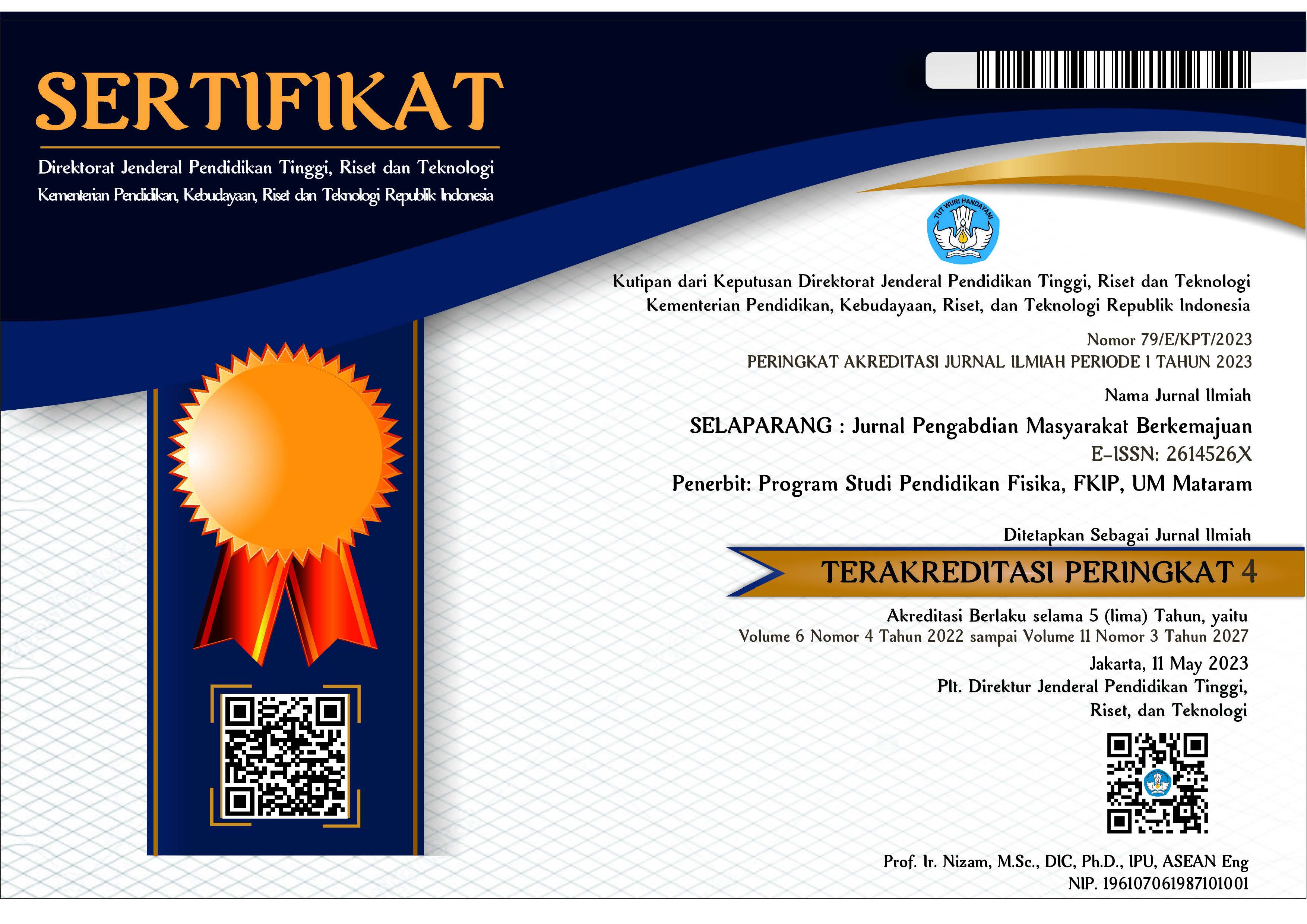PKM TUKANG BANGUNAN DESA SUKOGIDRI MELALUI TEKNIK PENULANGAN STRUKTUR RANGKA BETON BERTULANG BAMBU
Abstract
ABSTRAK
Salah satu potensi desa Sukogidri adalah banyaknya spesies bambu. Bambu merupakan energi terbarukan dan berkelanjutan yang belum dimanfaatkan maksimal untuk meningkatkan keberdayaan ekonomi masyarakat desa. Bambu mempunyai kuat tarik dan daya elastis cukup tinggi sehingga dapat dimanfaatkan untuk tulangan struktur beton sederhana, seperti rangka kuda-kuda, gewel, balok, dan kolom rumah sederhana. Belum maksimalnya manfaat bambu, faktor ekonomi dan keterbatasan pengetahuan para tukang bangunan tentang cara merangkai tulangan bambu untuk struktur rangka merupakan tiga masalah prioritas yang harus dipecahkan. Peningkatan pengetahuan cara merangkai tulangan bambu diperlukan untuk meningkatkan pengetahuan dan keberdayaan ekonomi tukang bangunan. Pengabdian ini merupakan aplikasi hasil penelitian tentang “Jembatan Pracetak Rangka Beton Bertulang Bambu” dan “Bambu sebagai Tulangan Beton”. PKM ini bertujuan memberdayakan dan meningkatkan pengetahuan serta keterampilan Kelompok Kreatif Tukang Bangunan agar mandiri secara ekonomi dan sosial. Metode pelaksanaan kegiatan ini dimulai dengan observasi dan koordinasi lapangan, bimbingan dan penyuluhan sampai melakukan evaluasi keberhasilan program. Peningkatan rata-rata kemampuan tukang bangunan setelah dilakukan pelatihan sebesar 34,1. Hal ini menunjukkan peningkatan yang terjadi pada tukang bangunan sebesar dua tingkat yakni dari tidak mahir menjadi mahir. Oleh karenanya kegiatan PKM ini dianggap berhasil.
Kata kunci: tukang; struktur; rangka; beton; bambu
ABSTRACT
One of the potentials of Sukogidri village is the abundance of bamboo species. Bamboo is a renewable and sustainable energy that has not been maximally utilized to increase the economic empowerment of village communities. From a technical perspective, bamboo has a high tensile strength and elasticity that can be utilized for reinforcement of simple concrete structures, such as trusses, gewels, beams, and columns of simple houses. The underutilization of bamboo, economic factors, and limited knowledge of builders on how to assemble bamboo reinforcement for frame structures are three priority problems to be solved. Increasing knowledge on how to assemble bamboo reinforcement is needed to increase the knowledge and economic empowerment of the community of builders in carrying out their profession. This service is an application of research results on "Bamboo Reinforced Concrete Truss Precast Bridge" and "Bamboo as Concrete Reinforcement". This PKM aims to empower and improve the knowledge and skills of the Creative Group of Builders to be economically and socially independent. The method of implementing this activity begins with observation and field coordination, guidance and counseling to evaluate the success of the programme. The average increase in the ability of builders between before and after training was 34.1. This shows the improvement that occurred in the builders by two levels, namely from not proficient to proficient. Therefore, this PKM activity is considered successful.
Keywords: builder; structure; frame; concrete; bamboo
Keywords
Full Text:
PDFReferences
Agarwal, A., Nanda, B., & Maity, D. (2014). Experimental investigation on chemically treated bamboo reinforced concrete beams and columns. Construction and Building Materials, 71, 610–617.
Amri Gunasti, Muhtar, Rofi Budi Hamduwibawa, Aditya Surya Manggala, Iskandar Umarie, Nely Ana Mufarida, Abadi Sanosra, Eko Budi Satoto, E. I. R. (2023). Peningkatan keahlian tukang menerapkan teknologi ferosemen dan tulangan beton dari bambu. SELAPARANG. Jurnal Pengabdian Masyarakat Berkemajuan, 07(02), 871–879.
Bhonde, D., Nagarnaik, P. B., Parbat, D. K., & Waghe, U. P. (2014). Experimental Analysis of Bending Stresses in Bamboo Reinforced Concrete Beam. Proceedings of 3rd International Conference on Recent Trends in Engineering & Technology (ICRTET’2014), 1–5.
Ghavami, K. (2005). Bamboo as reinforcement in structural concrete elements. Cement and Concrete Composites, 27(6), 637–649. https://doi.org/10.1016/j.cemconcomp.2004.06.002
Muhtar. (2019). Experimental data from strengthening bamboo reinforcement using adhesives and hose-clamps. Data in Brief, 27, 104827. https://doi.org/10.1016/j.dib.2019.104827
Muhtar. (2020a). Cracked pattern of bamboo reinforced concrete beams using double reinforcement with the strengthening on tensile reinforcement. International Journal of Engineering Research and Technology, 13(3), 608–612.
Muhtar. (2020b). Numerical validation data of tensile stress zones and crack zones in bamboo reinforced concrete beams using the Fortran PowerStation 4.0 program. Data in Brief, 29. https://doi.org/10.1016/j.dib.2020.105332
Muhtar. (2020c). The Prediction of Stiffness Reduction Non-Linear Phase in Bamboo Reinforced Concrete Beam Using the Finite Element Method (FEM) and Artificial Neural Networks (ANNs). Forests, 11(12), 1313. https://doi.org/https://doi.org/10.3390/f11121313
Muhtar, Dewi, S. M., Wisnumurti, & Munawir, A. (2016). Bond-slip improvement of bamboo reinforcement in concrete beam using hose clamps. Proceedings The 2nd International Multidisciplinary Conference 2016, 385–393.
Muhtar, Dewi, S. M., Wisnumurti, & Munawir, A. (2018). The Stiffness and Cracked Pattern of Bamboo Reinforced Concrete Beams Using a Hose Clamp. International Journal of Civil Engineering and Technology (IJCIET), 9(8), 273–284.
Muhtar, Dewi, S. M., Wisnumurti, & Munawir, A. (2019). Enhancing bamboo reinforcement using a hose-clamp to increase bond-stress and slip resistance. Journal of Building Engineering, 26. https://doi.org/10.1016/j.jobe.2019.100896
Muhtar, Gunasti, A., Manggala, A. S., Putra Nusant, A. F., Hanafi, & Nilogiri, A. (2020). Effect of reinforcement details on precast bridge frames of bamboo reinforced concrete to load capacity and crack patterns. International Journal of Engineering Research and Technology, 13(4), 631–636. https://doi.org/10.37624/ijert/13.4.2020.631-636
Muhtar, Gunasti, A., Suhardi, Nursaid, Irawati, Dewi, I. C., Dasuki, M., Ariyani, S., Fitriana, Mahmudi, I., Abadi, T., Rahman, M., Hidayatullah, S., Nilogiri, A., Galuh, S. D., Wardoyo, A. E., & Hamduwibawa, R. B. (2020). The prediction of stiffness of bamboo-reinforced concrete beams using experiment data and artificial neural networks (ANNs). Crystals, 10(9). https://doi.org/10.3390/cryst10090757
Puri, V., Chakrabortty, P., Anand, S., & Majumdar, S. (2017). Bamboo reinforced prefabricated wall panels for low cost housing. Journal of Building Engineering, 9, 52–59. https://doi.org/10.1016/j.jobe.2016.11.010
Rahman, M. M., Rashid, M. H., Hossain, M. A., Hasan, M. T., & Hasan, M. K. (2011). Performance evaluation of bamboo reinforced concrete beam. International Journal of Engineering & Technology IJET-IJENS, 11(04), 113–118.
Sabnani, C., Latkar, M. V, & Sharma, U. (2012). Bamboo an alternative building material for modest houses, to increase the stock of affordable housing, for the urban poor living close to bamboo producing regions in India. International Journal of Civil, Environmental, Structural, Construction and Architectural Engineering, 6(11), 977–988.
DOI: https://doi.org/10.31764/jpmb.v7i3.17157
Refbacks
- There are currently no refbacks.

This work is licensed under a Creative Commons Attribution-ShareAlike 4.0 International License.
______________________________________________________
Jurnal Selaparang
p-ISSN 2614-5251 || e-ISSN 2614-526X
EDITORIAL OFFICE:



















